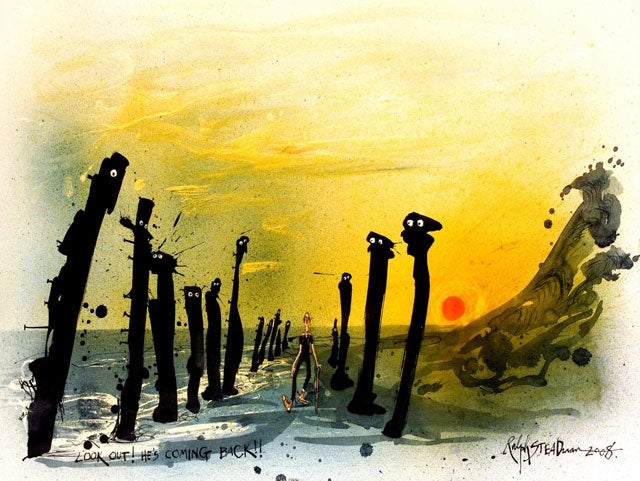Will Self: A real cliff hanger
PsychoGeography: "See there, I reckon that'll be next to go, bit in 't middle went a few days ago."

If my first day on the Holderness coast was odd, the second was utterly bizarre. In the early morning the coast was blanketed in a sea fog – or "fret" as they call it locally – and the dwellings along the cliff edge, which I got to see now from behind, were ramshackle, winnowed out by the gulf opening up in their former front gardens. And yet still people hung on here, despite the void encroaching beneath their feet. I headed south towards Hornsea, and passed through leisure park after leisure park, each one full of "static" (ha!) homes.
I stopped to talk to one of these modern-day Canutes, a stocky man in a white singlet who was drinking a cup of tea on the tiny balcony of his caravan. I asked him if he was worried about the encroaching gulf, but he was blithe: "When it gets too near they oop and move us back a few rows, like," he explained. "But we've 46 feet between uz and the cliff – there's a chap in the next park along, he's only 12, and his van i'nt even chained!" He shook his head at the idea of such folly then pointed out an embayment in the cliff between two promontories. "See there, I reckon that'll be next to go, bit in 't middle went a few days ago."
At Hornsea, snug behind its sea defences, I left the cliffs. All the inhabitants of the villages and towns along the Holderness coast believe that one settlement's defences – concrete bastions, steel groynes and floodgates – mean the next one along will be still more severely gouged. Certainly, as I trudged on I couldn't see much in the way of a beach until I reached Mappleton and descended into another world.
The cliffs here were high, and walking along underneath them I became fixated on the way the clayey mud mimicked everything from the finials and volutes of Gothic architecture to the physiognomy of the human face. The loess collapses either by being undercut by the sea, or due to what's called "rotational slumping". This looks exactly what it sounds like: the whole face of the cliff twisting round in response to some hideous and chthonic torsion. When the cliff has fallen the next tide turns the chunks of clay into round blobs, each studded with multi-coloured pebbles.
Eventually, I met a fossicker, who stood and chatted to me with his hammer held at a jaunty angle while his kid smashed some blobs beside us with his. As we were talking there was a puff of earth along the beach and a section of cliff fell down, perhaps 30 feet across. "You missed a really big 'un earlier on," the fossicker said, not that he appeared in the slightest bothered; he was more interested in telling me that he once found the skeleton of a bison trapped in the clay. Then we parted – and I walked on, the mud pressing on my right side, for now, having seen a fall I was seriously anxious for the first time: what if I were to expire thus, humped by the frigid shoulder of Ceres?
The next day was still stranger. Waking just past dawn at the Old Plough Inn at Hollym, I could see that the sea fret was back – and thicker. I walked across the misty fields to the beach and set off for Spurn Head, the disc of the sun up above like a radiant vent around which the mist swirled. On and on crunching over shingle and coarse sand, with the only people about sea fishermen in ones and twos, trapped in their taciturn maleness. I got to Easington, and here were still bigger piles of old concrete blockhouses mangled on the beach. On I trudged, past the carefully roped-off breeding grounds of terns, which chirruped a warning overhead.
Then, I was there: I could see, even in the mist, Spurn Head stretching out ahead of me in the gloom, its spine covered in marram grass and furze, its shingle flanks speared with the rotting spars of failed breakwaters. The Head is three miles long, and constantly being eroded along its northern side, and reconstituted on the southern, which fronts the Humber estuary. I was gripped now – despite seriously blistered feet – with a fierce need to reach my destination, and then, as if to reward me, just as I passed the lighthouse, and the end of the promontory was in sight, the sea fret rolled back and the sun came out. I say "the end", but if by this I mean a precise point, since Spurn Head is curved, I'm not sure that it was possible to establish the exact terminus of this parenthetic landmass. This noted, it may be that like any other piece of quoted speech, I remain there still – together with my words.

Join our commenting forum
Join thought-provoking conversations, follow other Independent readers and see their replies